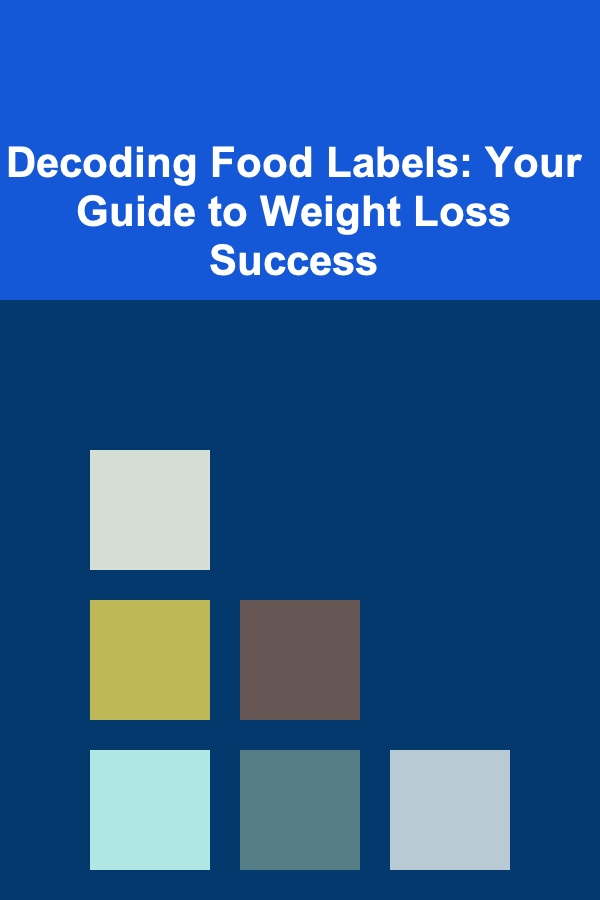
Decoding Food Labels: Your Guide to Weight Loss Success
ebook include PDF & Audio bundle (Micro Guide)
$12.99$11.99
Limited Time Offer! Order within the next:

Losing weight is a multifaceted journey that requires commitment, consistency, and, crucially, knowledge. While exercise and physical activity play vital roles, understanding the nutritional content of the foods you consume is paramount. In the modern food environment, where pre-packaged and processed foods dominate supermarket shelves, the ability to effectively read and interpret food labels becomes an indispensable skill for anyone striving to achieve their weight loss goals. This comprehensive guide will delve into the intricacies of food labels, providing you with the knowledge and tools to make informed food choices and navigate the complex landscape of nutrition information.
The Anatomy of a Food Label: Understanding the Core Components
Before embarking on our exploration of how to use food labels for weight loss, let's first dissect the various components that make up a standard food label. Understanding these elements is crucial for deciphering the information presented and making sound dietary decisions.
1. Serving Size: The Foundation of Nutritional Information
The serving size listed on a food label is arguably the most important piece of information. All the nutrient values displayed on the label are based on this specific serving size. It is critical to pay close attention to this value, as it may not always align with the amount you typically consume. For example, a bag of chips might list a serving size as "1 ounce (about 15 chips)," but if you eat the entire bag, you'll need to multiply all the nutrient values accordingly.
Key Takeaway: Always check the serving size and adjust the nutrient values to reflect your actual consumption.
Example:
A cereal box lists a serving size as 1 cup (30g) and contains 100 calories per serving. If you eat 2 cups of cereal, you're consuming 200 calories.
2. Calories: Energy In, Energy Out
The calorie count represents the amount of energy provided by one serving of the food. Calories are derived from three macronutrients: carbohydrates, fats, and proteins. Understanding your daily calorie needs is fundamental to weight loss. A calorie deficit (consuming fewer calories than you burn) is generally required to lose weight.
Key Takeaway: Be mindful of calorie counts and track your daily intake to create a calorie deficit if you're aiming to lose weight.
It's not just about the total calories, but also where those calories are coming from (the macronutrient composition, as we'll discuss later).
3. Macronutrients: The Building Blocks of Your Diet
Macronutrients are the essential nutrients that provide your body with energy. The food label provides information on the amount of fat , carbohydrates , and protein present in each serving. Understanding the role of each macronutrient is vital for designing a weight-loss-friendly diet.
- Fat: Provides energy, supports cell growth, and helps absorb certain vitamins. The label will break down fat into saturated fat, trans fat, and unsaturated fats (monounsaturated and polyunsaturated). Aim to limit saturated and trans fats, as they are linked to heart disease. Prioritize unsaturated fats, which are considered healthy fats.
- Carbohydrates: The body's primary source of energy. The label breaks down carbohydrates into total carbohydrates, dietary fiber, and sugars. Focus on complex carbohydrates (whole grains, fruits, vegetables) and prioritize fiber, which promotes satiety and helps regulate blood sugar. Limit added sugars.
- Protein: Essential for building and repairing tissues, producing enzymes and hormones, and supporting a healthy immune system. Aim for adequate protein intake to preserve muscle mass during weight loss.
Key Takeaway: Pay attention to the types of fats, carbohydrates, and protein in your food. Prioritize healthy fats, complex carbohydrates, and adequate protein intake.
Example:
A nutrition label shows: Total Fat 10g (Saturated Fat 3g, Trans Fat 0g), Total Carbohydrates 20g (Dietary Fiber 5g, Sugars 8g), Protein 5g.
4. Micronutrients: Vitamins and Minerals
Micronutrients, including vitamins and minerals, are essential for various bodily functions. While they don't provide calories, they are crucial for overall health and well-being. Food labels often list the percentage Daily Value (%DV) of key micronutrients such as Vitamin A, Vitamin C, Calcium, and Iron. A higher %DV indicates that the food is a good source of that particular nutrient.
Key Takeaway: Aim to choose foods that are rich in essential vitamins and minerals to support overall health during weight loss.
5. % Daily Value (%DV): A Relative Measure
The % Daily Value (%DV) indicates the percentage of the recommended daily intake of a nutrient that is provided by one serving of the food. The %DV is based on a 2,000-calorie diet. Generally, 5% DV or less is considered low, and 20% DV or more is considered high for a particular nutrient.
Key Takeaway: Use the %DV to quickly assess whether a food is a good source of a particular nutrient.
6. Ingredient List: A Window into What's Really Inside
The ingredient list is often overlooked, but it's a crucial source of information. Ingredients are listed in descending order by weight, meaning the ingredient that is present in the largest amount is listed first. Pay attention to the ingredient list to identify hidden sugars, unhealthy fats, artificial additives, and processed ingredients. The shorter and simpler the ingredient list, the better.
Key Takeaway: Scrutinize the ingredient list to identify potential red flags and choose foods with whole, unprocessed ingredients.
Example:
Instead of "High Fructose Corn Syrup, Partially Hydrogenated Vegetable Oil, Artificial Flavors," look for ingredients like "Whole Wheat Flour, Oats, Fruits, Vegetables, Nuts."
Using Food Labels Strategically for Weight Loss
Now that we have a firm grasp of the individual components of a food label, let's explore how to leverage this knowledge to support your weight loss efforts.
1. Prioritizing Protein for Satiety and Muscle Preservation
Protein is a powerful tool for weight loss. It promotes satiety (feeling full), helps preserve muscle mass during calorie restriction, and boosts metabolism slightly. When reading food labels, aim to choose foods that are relatively high in protein and low in unhealthy fats and added sugars.
How to Apply:
- Look for foods with at least 15-20 grams of protein per serving.
- Choose lean protein sources like chicken breast, fish, beans, lentils, and tofu.
- Consider protein-rich snacks like Greek yogurt, nuts, and hard-boiled eggs.
2. Focusing on Fiber for Digestive Health and Fullness
Fiber is another key nutrient for weight loss. It adds bulk to your diet, promoting feelings of fullness and helping to regulate blood sugar levels. Adequate fiber intake also supports healthy digestion.
How to Apply:
- Aim for foods with at least 3-5 grams of fiber per serving.
- Choose whole grains, fruits, vegetables, legumes, and nuts as your primary sources of carbohydrates.
- Be aware that "enriched" grains are often lower in fiber than whole grains.
3. Limiting Added Sugars for Stable Energy Levels and Reduced Calorie Intake
Added sugars contribute empty calories to your diet and can lead to blood sugar spikes and crashes, which can sabotage your weight loss efforts. The food label lists "Sugars," which includes both naturally occurring sugars (like those in fruit) and added sugars. Ideally, you should focus on minimizing added sugars. The ingredient list is your best resource for identifying added sugars, which can be listed under various names.
Common Names for Added Sugars:
- High Fructose Corn Syrup
- Sucrose
- Glucose
- Fructose
- Dextrose
- Corn Syrup
- Maltose
- Agave Nectar
- Honey
- Molasses
- Brown Sugar
How to Apply:
- Aim for foods with minimal added sugars.
- Be cautious of foods that list sugar as one of the first few ingredients.
- Choose unsweetened or lightly sweetened alternatives whenever possible.
- Focus on getting your sweetness from natural sources like fruits.
4. Choosing Healthy Fats and Avoiding Unhealthy Ones
Not all fats are created equal. Unsaturated fats (monounsaturated and polyunsaturated) are considered healthy fats and can be beneficial for heart health and overall well-being. Saturated and trans fats, on the other hand, should be limited. Trans fats are particularly harmful and should be avoided altogether.
Healthy Fat Sources:
- Avocados
- Nuts and seeds
- Olive oil
- Fatty fish (salmon, tuna, mackerel)
How to Apply:
- Limit your intake of saturated fat to less than 10% of your daily calorie intake.
- Avoid trans fats entirely.
- Choose foods that are rich in unsaturated fats.
- Read the ingredient list to identify hidden sources of unhealthy fats, such as partially hydrogenated vegetable oils.
5. Being Mindful of Sodium Intake
Excessive sodium intake can lead to water retention and bloating, which can hinder your weight loss efforts. It can also increase the risk of high blood pressure.
How to Apply:
- Aim for foods with less than 140mg of sodium per serving.
- Be cautious of processed foods, canned goods, and sauces, which are often high in sodium.
- Choose low-sodium or no-salt-added options whenever possible.
- Use herbs and spices to flavor your food instead of salt.
6. Comparing Similar Products
Food labels are especially useful when comparing similar products. For example, if you're trying to choose between two different brands of yogurt, you can compare their calorie counts, protein content, sugar content, and fat content to make the most informed choice.
How to Apply:
- Compare the nutrient values of similar products.
- Pay attention to the serving size to ensure a fair comparison.
- Choose the product that best aligns with your weight loss goals.
7. Understanding Common Labeling Claims
Food labels often include claims such as "low fat," "reduced sugar," "high fiber," and "organic." It's important to understand what these claims actually mean, as they can sometimes be misleading.
Common Labeling Claims and Their Definitions:
- Low Fat: Contains 3 grams of fat or less per serving.
- Reduced Fat: Contains at least 25% less fat than the regular version.
- Low Sodium: Contains 140mg of sodium or less per serving.
- Reduced Sodium: Contains at least 25% less sodium than the regular version.
- High Fiber: Contains 5 grams of fiber or more per serving.
- Good Source of Fiber: Contains 2.5 to 4.9 grams of fiber per serving.
- Sugar-Free: Contains less than 0.5 grams of sugar per serving.
- Reduced Sugar: Contains at least 25% less sugar than the regular version.
- Organic: Produced according to specific organic standards, which typically involve avoiding synthetic pesticides, fertilizers, and genetically modified organisms (GMOs).
Key Takeaway: While labeling claims can be helpful, don't rely on them solely. Always read the full nutrition label and ingredient list to get a complete picture of the food's nutritional content.
Beyond the Label: Holistic Considerations for Weight Loss
While food labels are a valuable tool, it's important to remember that weight loss is a holistic process that involves more than just reading numbers on a package. Consider these additional factors:
1. Whole Foods vs. Processed Foods
Focus on building your diet around whole, unprocessed foods like fruits, vegetables, lean proteins, and whole grains. These foods are naturally nutrient-rich and typically lower in calories, added sugars, and unhealthy fats than processed foods. While reading labels is still important for these foods (especially for portion control), the focus shifts to simply ensuring a balanced intake.
2. Portion Control
Even healthy foods can contribute to weight gain if consumed in excessive quantities. Pay attention to serving sizes and practice portion control to manage your calorie intake effectively. Using smaller plates and bowls can be a helpful strategy.
3. Mindful Eating
Pay attention to your hunger and fullness cues, and eat slowly and deliberately. Avoid distractions while eating, such as watching television or using your phone. Mindful eating can help you prevent overeating and develop a healthier relationship with food.
4. Hydration
Drinking plenty of water is essential for weight loss. Water helps you feel full, boosts metabolism, and aids in digestion. Aim for at least 8 glasses of water per day.
5. Regular Physical Activity
Combine healthy eating with regular physical activity to maximize your weight loss results. Aim for at least 150 minutes of moderate-intensity aerobic exercise or 75 minutes of vigorous-intensity aerobic exercise per week, along with strength training exercises at least two days per week.
6. Sleep and Stress Management
Adequate sleep and effective stress management are crucial for weight loss. Sleep deprivation and chronic stress can disrupt hormones that regulate appetite and metabolism, leading to weight gain. Aim for 7-9 hours of sleep per night and practice stress-reducing activities like yoga, meditation, or spending time in nature.
Conclusion: Empowering Yourself with Knowledge
Mastering the art of reading food labels is a powerful skill that can empower you to make informed food choices and achieve your weight loss goals. By understanding the components of a food label, prioritizing key nutrients, limiting unhealthy ingredients, and considering holistic factors, you can navigate the complex food environment with confidence and create a sustainable and healthy eating plan. Remember, weight loss is a journey, not a destination. Be patient, consistent, and celebrate your progress along the way.
Disclaimer: This information is for educational purposes only and should not be considered medical advice. Consult with a registered dietitian or healthcare professional before making any significant changes to your diet or exercise routine.

Building a Digital Tutorial Series: An Actionable Guide
Read More
How to Educate Customers on Using AR Product Visualization in Dropshipping
Read More
How to Leverage Social Media to Sell Homemade Products
Read More
How to Plan for Major Expenses (e.g., Buying a Home, Paying for College)
Read More
How to Understand the Future Trends in Print-on-Demand
Read More
How to Overcome Cognitive Biases
Read MoreOther Products

Building a Digital Tutorial Series: An Actionable Guide
Read More
How to Educate Customers on Using AR Product Visualization in Dropshipping
Read More
How to Leverage Social Media to Sell Homemade Products
Read More
How to Plan for Major Expenses (e.g., Buying a Home, Paying for College)
Read More
How to Understand the Future Trends in Print-on-Demand
Read More